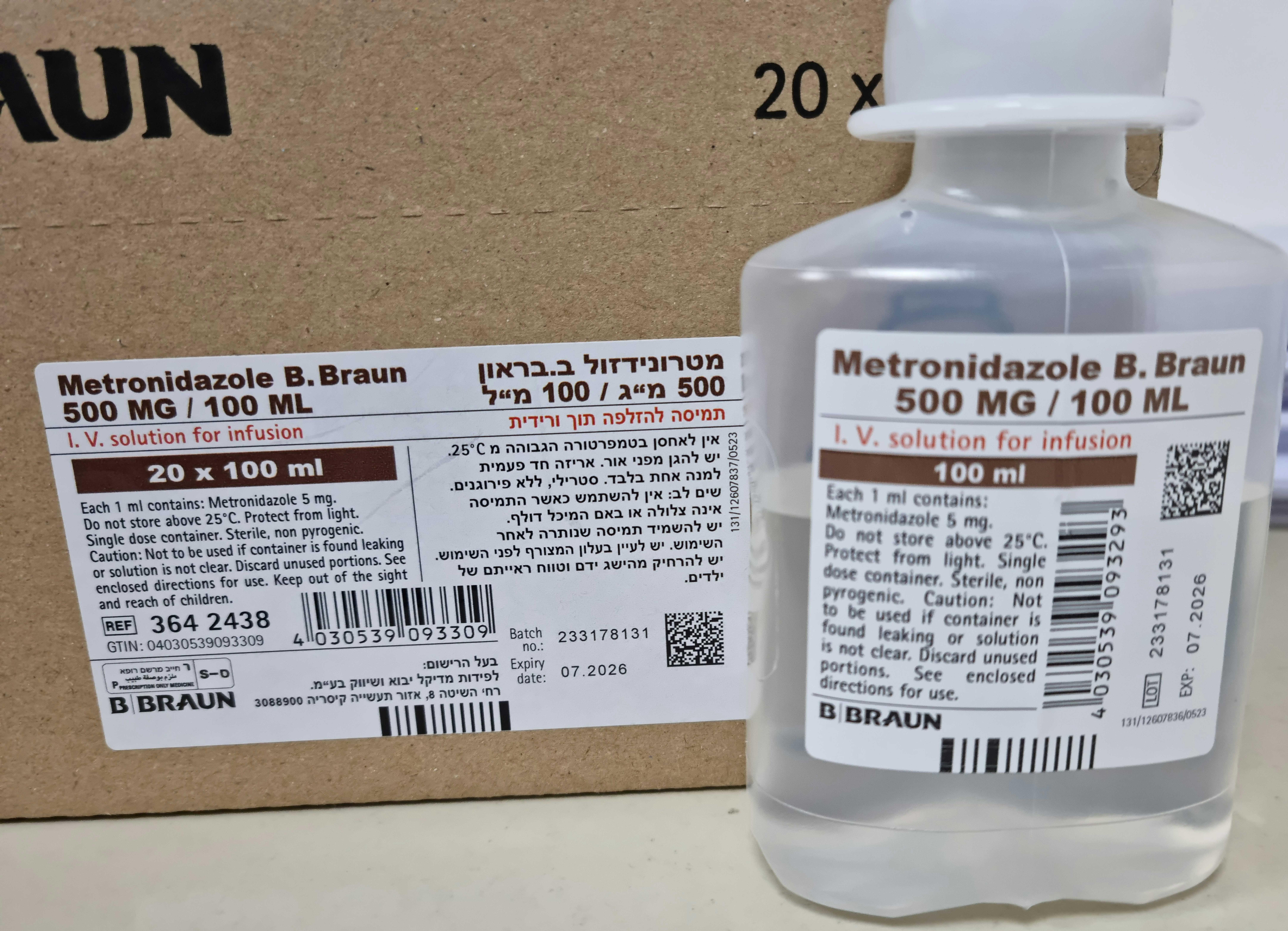Quest for the right Drug

מטרונידזול ב. בראון 500 מ"ג / 100 מ"ל Metronidazole B.Braun 500 MG / 100 ML (METRONIDAZOLE)
תרופה במרשם
תרופה בסל
נרקוטיקה
ציטוטוקסיקה
צורת מתן:
תוך-ורידי : I.V
צורת מינון:
תמיסה לאינפוזיה : SOLUTION FOR INFUSION
עלון לרופא
מינוניםPosology התוויות
Indications תופעות לוואי
Adverse reactions התוויות נגד
Contraindications אינטראקציות
Interactions מינון יתר
Overdose הריון/הנקה
Pregnancy & Lactation אוכלוסיות מיוחדות
Special populations תכונות פרמקולוגיות
Pharmacological properties מידע רוקחי
Pharmaceutical particulars אזהרת שימוש
Special Warning עלון לרופא
Physicians Leaflet
Special Warning : אזהרת שימוש
4.4 Special warnings and precautions for use Patients with hepatic impairment In patients with severe liver damage metronidazole should only be used if its expected benefits clearly outweigh potential hazards. Metronidazole is mainly metabolised by hepatic oxidation. Substantial impairment of metronidazole clearance may occur in the presence of advanced hepatic insufficiency. Significant cumulation may occur in patients with hepatic encephalopathy and the resulting high plasma concentrations of metronidazole may contribute to the symptoms of the encephalopathy. Metronidazole should therefore be administered with caution to patients with hepatic encephalopathy. (see section 4.2). Due to the risk of aggravation, metronidazole should also be used in patients with active or chronic severe peripheral and central nervous system diseases only if its expected benefits clearly outweigh potential hazards. Convulsive seizures, myoclonus and peripheral neuropathy, the latter mainly characterized by numbness or paresthesia of an extremity, have been reported in patients treated with metronidazole. The appearance of abnormal neurological signs demands the prompt evaluation of the benefit/risk ratio of the continuation of therapy. Patients should be advised not to take alcohol during Metronidazole therapy and at least 48 hours afterwards because of a disulfram-like effect (flushing, vomiting, tachycardia). In the case of severe hypersensitivity reactions (e.g. anaphylactic shock), treatment with Metronidazole B.Braun 500 MG / 100 ML must be discontinued immediately and established emergency treatment must be initiated by qualified healthcare professionals. Severe persistent diarrhoea occurring during treatment or during the subsequent weeks may be due to pseudomembranous colitis (in most cases caused by clostridium difficile), see section 4.8. This intestinal disease, precipitated by the antibiotic treatment, may be life-threatening and requires immediate appropriate treatment. Anti-peristaltic medicinal products must not be given. The duration of therapy with metronidazole or drugs containing other nitroimidazoles should not exceed 10 days. Only in specific elective cases and if definitely needed, the treatment period may be extended, accompanied by appropriate clinical and laboratory monitoring. Repeat therapy should be restricted as much as possible and to specific elective cases only. These restrictions must be observed strictly because the possibility of metronidazole developing mutagenic activity cannot be safely excluded and because in animal experiments an increase of the incidence of certain tumours has been noted. Hepatotoxicity in patients with Cockayne Syndrome Cases of severe hepatotoxicity/acute hepatic failure, including cases with a fatal outcome with very rapid onset after treatment initiation in patients with Cockayne syndrome have been reported with products containing metronidazole for systemic use. In this population, metronidazole should not be used unless the benefit is considered to outweigh the risk and if no alternative treatment is available. Liver function tests must be performed just prior to the start of therapy, throughout and after end of treatment until liver function is within normal ranges, or until the baseline values are reached. If the liver function tests become markedly elevated during treatment, the drug should be discontinued. Patients with Cockayne syndrome should be advised to immediately report any symptoms of potential liver injury to their physician and stop taking metronidazole (see section 4.8). Prolonged therapy with metronidazole may be associated with bone marrow depression, leading to an impairment of haematopoiesis. Manifestations see section 4.8. Blood cell counts should be carefully monitored during prolonged therapy. Special warnings / precautions regarding excipients This medicinal product contains 14 mmol (or 322 mg) sodium per 100 ml, equivalent to 16% of the WHO recommended maximum daily intake of 2 g sodium for an adult. Interference with laboratory tests Metronidazole interferes with the enzymatic-spectrophotometric determination of aspartate aminotransferase (AST), alanine aminotransferase (ALT), lactate dehydrogenase (LDH), triglycerides and glucose hexokinase resulting in decreased values (possibly down to zero). Metronidazole has a high absorbance at the wavelength at which nicotinamideadenine dinucleotide (NADH) is determined. Therefore elevated liver enzyme concentrations may be masked by metronidazole when measured by continuous-flow methods based on endpoint decrease in reduced NADH. Unusually low liver enzyme concentrations, including zero values, have been reported. Patients should be warned that Metronidazole may darken urine.
Effects on Driving
4.7 Effects on ability to drive and use machines Patients should be warned about the potential for drowsiness, dizziness, confusion, hallucinations, convulsions or transient visual disorders, and are advised not to drive or operate machinery if these symptoms occur.

שימוש לפי פנקס קופ''ח כללית 1994
לא צוין
תאריך הכללה מקורי בסל
לא צוין
הגבלות
לא צוין
מידע נוסף
